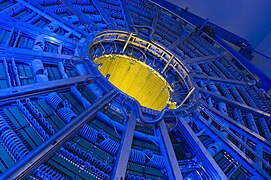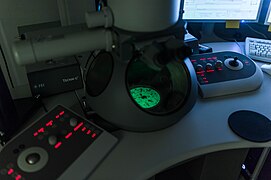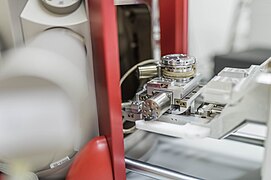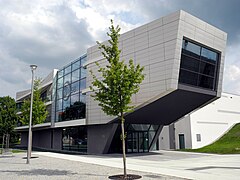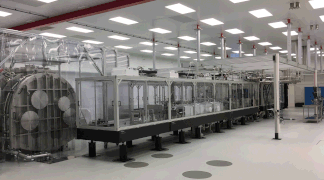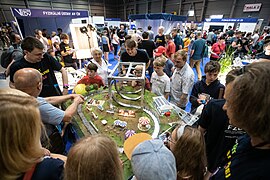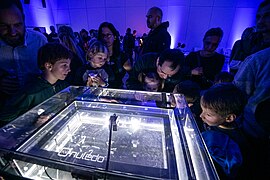Institute of Physics of the Czech Academy of Sciences
Fyzikální ústav Akademie věd České republiky | |
 | |
| Abbreviation | FZU |
|---|---|
| Formation | 1 January 1954 |
| Location | |
| Coordinates | 50°07′24″N 14°28′08″E / 50.123471°N 14.468835°E |
| Fields | Physics research |
Director | Michael Prouza |
Parent organization | Czech Academy of Sciences |
Staff | c. 1100 |
Students | c. 130 |
| Website | https://www.fzu.cz |
Institute of Physics of the Czech Academy of Sciences (FZU, Fyzikální ústav Akademie věd České republiky) is a public research institution in the Czech Republic and a part of the Czech Academy of Sciences.[1] The Institute specialises in fundamental and applied research across five fields: particle physics, condensed matter physics and solid-state physics, optics and physics of plasma. FZU is also involved in education at the university level, supervision of Master and PhD students and science communication.
Research and research divisions
[edit]FZU is an internationally renowned centre of scientific excellence. Research teams at FZU are engaged in a wide range of research activities, have a large international representation, and the proportion of women is approximately 30%. Most of the teams achieve world-leading and internationally excellent results and some teams are among the absolute top R&D performers worldwide, especially in the fields of spintronics, structure analysis and crystallography, atomic and molecular structures, as well as classical and quantum optics.[2]
FZU researchers regularly publish in respected academic journals such as Science(e.g. [3][4][5]), Nature[6][7][8] and other Nature Portfolio journals,[9][10][11] Advanced Functional Materials,[12][13][14] Physical Review Letters,[15][16][17] The Astrophysical Journal[18][19] and others.[20][21]
FZU has five research divisions,[22] each comprises several departments. Division of Solid State Physics is located in Prague - Střešovice district (north-western part of Prague), Division of High Power Lasers is mostly in Dolní Břežany, small town near the southern border of Prague; three other divisions are located in the "Slovanka" research complex in Prague - Libeň.
Division of Elementary Particle Physics
[edit]The Division of Elementary Particle Physics is located in Prague Slovanka research complex. It comprises five departments: Department of Astroparticle Physics, Department of Experimental Particle Physics, Department of Theory of Elementary Particles, Department of Detector Development and Data Processing, Department of Cosmology and Department of Gravitational Physics.
The work of the Division is to investigate the structure of matter at the level of subatomic particles and the forces that act between them. It participates in the ATLAS experiment at the LHC accelerator at CERN and the astroparticle physics experiment carried out by the Pierre Auger Observatory in Argentina.
As a part of the international CALICE project, it is involved in the development of detectors for the planned International Linear Collider (ILC). The Division is also a major contributor to the development and construction of the Cherenkov Telescope Array (CTA).[23]
To a lesser extent, the Division also participates in other experiments at CERN (ALICE, TOTEM), the NOvA neutrino experiment,[24] the Vera C. Rubin Observatory project and the LISA cosmic gravitational wave detector.
-
Computing centre in FZU
-
Laboratory for silicone particle detector testing (probe detail)
-
Mirrors of the fluorescence detector at Pierre Auger Observatory in Argentina
-
Northern site of Cherenkov Telescope Array (La Palma)
Division of Condensed Matter Physics
[edit]The Department of Condensed Matter Physics has six departments in the research complex Slovanka: the Department of Magnetic Measurements and Materials (which also includes a Joint Laboratory of Magnetic Studies with the MFF UK), Department of Dielectrics, Department of Materials Analysis, Department of Functional Materials, Department of Condensed Matter Theory and Department of Chemistry.
The Division's research focuses on theoretical and experimental studies of the structure and properties of mainly multiferroic, piezoelectric and spintronic materials, liquid crystals, modern metallic materials, functional engineering materials such as shape memory alloys, diamond coatings, Heusler alloys and thin films.
-
Detail of Instron deformation machine in Department of Functional Materials
-
Time-domain terahertz spectrometers (detail) in Department of Dielectrics
-
Transmission electron microscope in Department of Material Analysis
-
Crystal-growth apparatus (Czochralski method)
Division of Solid State Physics
[edit]The Division is located in Prague at Cukrovarnická Street and has a total of 7 departments: Department of Surfaces and Molecular Structures, Department of Spintronics and Nanoelectronics (which also includes a joint optospintronics laboratory with MFF UK), Department of Structure Analysis, Department of Magnetics and Superconductors, Department of Thin Films and Nanostructures, Department of Semiconductors and Department of Optical Materials
Research in the Division focuses primarily on magnetically and optically active materials, nanocrystalline forms of silicon, III-V semiconductors, diamond and graphite, and nanostructures for biological, medical and microelectronic applications.
-
Division headquarters in Cukrovarnická street (Prague)
-
Apparatus for molecular-beam epitaxy in Department of Spintronics
-
Detail of scanning electron microscope Maia 3 Tescan
-
Atomic layer deposition system
-
Scintillation crystals in Department of Optical Materials
Division of Optics
[edit]The Division of Optics has four departments located in the Slovanka research complex: Department of Optical and Biophysical Systems, Department of Low Temperature Plasma, Department of Analysis of Functional Materials and Department of Optical and Mechanical Workshops.
The fifth department is the Joint Laboratory of Optics, which FZU shares with Palacký University in Olomouc (central Moravia) and is also located there.[25]
The division focuses on the investigation of optical radiation properties as well as research on optical materials and structures (including doped oxides and their surfaces, multilayer systems and nanostructured ceramics and crystals). In the field of classical optics, the problems of interferometry, holography, fractal optics, coherence and statistical behaviour of light beams are addressed.
In addition, they are involved in the development of applications for scientific and medical use, including X-ray optics for synchrotron radiation.
-
Magnetron sputtering chamber
-
Linear plasma system with a series of hollow cathodes for rapid reactive thin film deposition
-
Researcher working with the Olympus IXplore SpinSR10 spinning disk confocal super-resolution microscope
-
Metal 3D printer utilizing the selective laser melting (SLM) technology. View of the printing chamber with printing in progress.
Division of High Power Lasers – HiLASE Centre
[edit]Division of High Power Lasers – HiLASE Centre has 7 departments in total: at the research complex in the norther part of Prague are located the Radiation and Chemical Physics Department (PALS Research Centre operated jointly with the Institute of Plasma Physics of the CAS) and a part of the PALS Technical Support Department. Five other departments are located in the HiLASE Centre building in Dolní Břežany: the Department of Advanced Laser Development, the Department of Industrial Laser Applications, the Department of Scientific Laser Applications, the Engineering and Technical Support Department and the Project Management Department.
The division focuses its research on laser plasmas generated by pulsed power lasers emitting in the infrared, visible and soft X-ray region.
The division researchers are also involved in the development of lasers such as the kilowatt-class continuous supersonic chemical oxygen-iodine laser (COIL) in collaboration with the Laser Science & Technology Centre, India and diode-pumped high repetition rate lasers in the HiLASE project.
-
PALS centre
-
PALS - detail
-
HiLASE Centre building in Dolní Břežany
ELI Beamlines Project Division
[edit]The division existed from 2012[26] to 2022 with headquarters in Dolní Břežany (Za Radnicí 835) near Prague. The main purpose of the division was the preparation and implementation of the ELI Beamlines laser centre, which is part of the European ELI ERIC consortium from January 2023.[27]
-
ELI Beamlines headquarters in Dolní Břežany
-
Experimental setup ELIMAIA
-
Laser system L3 HAPLS
Dvořák lecture
[edit]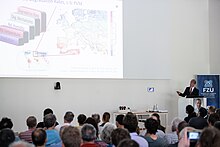
Since 2009, the Institute of Physics has been organizing the Dvořák Lectures (Dvořákovy přednášky), which are held once a year and the lecturer is an internationally recognized authority in one of the fields of physics. The lecture is named after Vladimír Dvořák, a physicist in the field of solid state physics and also the director of FZU in 1993–2001. Among the speakers were Yoshihiro Ishibashi, Anton Zeilinger, Dieter Vollhardt, Allan H. MacDonald, Peter Jenni, Orazio Svelto, Janos Hajdu, Marco Cavaglià, Paul Lecoq, Shaoyi Jiang, Ramamoorthy Ramesh, Jorge J. Rocca, Marko Topic.[28]
Outreach activities
[edit]FZU participates in a number of activities popularizing research among the public, for example through lectures, excursions, workshops for students, etc. The biggest events include the Science Fair (Veletrh vědy), the Academy Week (Open Days) and the European Researchers' Night. FZU also participates in ScienceFest (VědaFest), Take Back Your Streets (Zažít město jinak) and many other events in the Czech Republic.
The Institute of Physics has a number of interesting tools that help in explaining advanced physics topics - for example, a cloud chamber, a laser maze, a model of a superconducting (maglev) train, or a photovoltaic tent.[29]
-
Science Fair visitors around superconducting model
-
Public talk in FZU
-
Visitors around cloud chamber during Researchers' Night
-
Excursion for public in FZU laboratory
-
Laser maze
-
Lasermapping on FZU building during street festival
References
[edit]- ^ "Rejstřík veřejných výzkumných institucí". rvvi.msmt.cz. Retrieved 9 July 2024.
- ^ "Evaluation of research and professional activity of research-oriented institutes of the Czech Academy of Sciences for the period 2015–2019". pp. 1–8.
- ^ Brázda, Petr; Palatinus, Lukáš; Babor, Martin (17 May 2019). "Electron diffraction determines molecular absolute configuration in a pharmaceutical nanocrystal". Science. 364 (6441): 667–669. doi:10.1126/science.aaw2560. ISSN 0036-8075. PMID 31097664.
- ^ Mallada, B.; Gallardo, A.; Lamanec, M.; de la Torre, B.; Špirko, V.; Hobza, P.; Jelinek, P. (12 November 2021). "Real-space imaging of anisotropic charge of σ-hole by means of Kelvin probe force microscopy". Science. 374 (6569): 863–867. doi:10.1126/science.abk1479. ISSN 0036-8075. PMID 34762455.
- ^ Palatinus, L.; Brázda, P.; Boullay, P.; Perez, O.; Klementová, M.; Petit, S.; Eigner, V.; Zaarour, M.; Mintova, S. (13 January 2017). "Hydrogen positions in single nanocrystals revealed by electron diffraction". Science. 355 (6321): 166–169. doi:10.1126/science.aak9652. ISSN 0036-8075. PMID 28082587.
- ^ Li, Qian; Stoica, Vladimir A.; Paściak, Marek; Zhu, Yi; Yuan, Yakun; Yang, Tiannan; McCarter, Margaret R.; Das, Sujit; Yadav, Ajay K.; Park, Suji; Dai, Cheng; Lee, Hyeon Jun; Ahn, Youngjun; Marks, Samuel D.; Yu, Shukai (April 2021). "Subterahertz collective dynamics of polar vortices". Nature. 592 (7854): 376–380. doi:10.1038/s41586-021-03342-4. ISSN 1476-4687. PMID 33854251.
- ^ Peng, Jinbo; Cao, Duanyun; He, Zhili; Guo, Jing; Hapala, Prokop; Ma, Runze; Cheng, Bowei; Chen, Ji; Xie, Wen Jun; Li, Xin-Zheng; Jelínek, Pavel; Xu, Li-Mei; Gao, Yi Qin; Wang, En-Ge; Jiang, Ying (May 2018). "The effect of hydration number on the interfacial transport of sodium ions". Nature. 557 (7707): 701–705. doi:10.1038/s41586-018-0122-2. ISSN 1476-4687. PMID 29760468.
- ^ Sugimoto, Yoshiaki; Pou, Pablo; Abe, Masayuki; Jelinek, Pavel; Pérez, Rubén; Morita, Seizo; Custance, Óscar (March 2007). "Chemical identification of individual surface atoms by atomic force microscopy". Nature. 446 (7131): 64–67. doi:10.1038/nature05530. ISSN 1476-4687. PMID 17330040.
- ^ Lawrence, James; Berdonces-Layunta, Alejandro; Edalatmanesh, Shayan; Castro-Esteban, Jesús; Wang, Tao; Jimenez-Martin, Alejandro; de la Torre, Bruno; Castrillo-Bodero, Rodrigo; Angulo-Portugal, Paula; Mohammed, Mohammed S. G.; Matěj, Adam; Vilas-Varela, Manuel; Schiller, Frederik; Corso, Martina; Jelinek, Pavel (December 2022). "Circumventing the stability problems of graphene nanoribbon zigzag edges". Nature Chemistry. 14 (12): 1451–1458. doi:10.1038/s41557-022-01042-8. ISSN 1755-4349. PMC 10665199. PMID 36163268.
- ^ Železný, J.; Wadley, P.; Olejník, K.; Hoffmann, A.; Ohno, H. (March 2018). "Spin transport and spin torque in antiferromagnetic devices". Nature Physics. 14 (3): 220–228. doi:10.1038/s41567-018-0062-7. ISSN 1745-2481.
- ^ Amin, O. J.; Poole, S. F.; Reimers, S.; Barton, L. X.; Dal Din, A.; Maccherozzi, F.; Dhesi, S. S.; Novák, V.; Krizek, F.; Chauhan, J. S.; Campion, R. P.; Rushforth, A. W.; Jungwirth, T.; Tretiakov, O. A.; Edmonds, K. W. (August 2023). "Antiferromagnetic half-skyrmions electrically generated and controlled at room temperature". Nature Nanotechnology. 18 (8): 849–853. doi:10.1038/s41565-023-01386-3. ISSN 1748-3395. PMC 10427425. PMID 37157021.
- ^ Olshtrem, A.; Panov, I.; Chertopalov, S.; Zaruba, K.; Vokata, B.; Sajdl, P.; Lancok, J.; Storch, J.; Církva, V.; Svorcik, V.; Kartau, M.; Karimullah, A. S.; Vana, J.; Lyutakov, O. (July 2023). "Chiral Plasmonic Response of 2D Ti 3 C 2 T x Flakes: Realization and Applications". Advanced Functional Materials. 33 (30). doi:10.1002/adfm.202212786. ISSN 1616-301X.
- ^ Santhini, Vijai M.; Stetsovych, Oleksandr; Ondráček, Martin; Mendieta Moreno, Jesus I.; Mutombo, Pingo; de la Torre, Bruno; Švec, Martin; Klívar, Jiří; Stará, Irena G.; Vázquez, Héctor; Starý, Ivo; Jelínek, Pavel (January 2021). "On-Surface Synthesis of Polyferrocenylene and its Single-Chain Conformational and Electrical Transport Properties". Advanced Functional Materials. 31 (5). doi:10.1002/adfm.202006391. ISSN 1616-301X.
- ^ Pushkarev, Vladimir; Němec, Hynek; Paingad, Vaisakh C.; Maňák, Jan; Jurka, Vlastimil; Novák, Vít; Ostatnický, Tomáš; Kužel, Petr (January 2022). "Charge Transport in Single-Crystalline GaAs Nanobars: Impact of Band Bending Revealed by Terahertz Spectroscopy". Advanced Functional Materials. 32 (5). doi:10.1002/adfm.202107403. ISSN 1616-301X.
- ^ de la Torre, Bruno; Švec, Martin; Foti, Giuseppe; Krejčí, Ondřej; Hapala, Prokop; Garcia-Lekue, Aran; Frederiksen, Thomas; Zbořil, Radek; Arnau, Andres; Vázquez, Héctor; Jelínek, Pavel (16 October 2017). "Submolecular Resolution by Variation of the Inelastic Electron Tunneling Spectroscopy Amplitude and its Relation to the AFM/STM Signal". Physical Review Letters. 119 (16): 166001. arXiv:1710.06180. doi:10.1103/PhysRevLett.119.166001. PMID 29099201.
- ^ Pierre Auger Collaboration; Aab, A.; Abreu, P.; Aglietta, M.; Albury, J. M.; Allekotte, I.; Almela, A.; Alvarez-Muñiz, J.; Alves Batista, R.; Anastasi, G. A.; Anchordoqui, L.; Andrada, B.; Andringa, S.; Aramo, C.; Araújo Ferreira, P. R. (16 April 2021). "Measurement of the Fluctuations in the Number of Muons in Extensive Air Showers with the Pierre Auger Observatory". Physical Review Letters. 126 (15): 152002. arXiv:2102.07797. doi:10.1103/PhysRevLett.126.152002. PMID 33929235.
- ^ Yao, Yugui; Kleinman, Leonard; MacDonald, A. H.; Sinova, Jairo; Jungwirth, T.; Wang, Ding-sheng; Wang, Enge; Niu, Qian (22 January 2004). "First Principles Calculation of Anomalous Hall Conductivity in Ferromagnetic bcc Fe". Physical Review Letters. 92 (3): 037204. arXiv:cond-mat/0307337. doi:10.1103/PhysRevLett.92.037204. PMID 14753904.
- ^ Aab, A.; Abreu, P.; Aglietta, M.; Albury, J. M.; Allekotte, I.; Almela, A.; Alvarez-Muñiz, J.; Batista, R. Alves; Anastasi, G. A.; Anchordoqui, L.; Andrada, B.; Andringa, S.; Aramo, C.; Ferreira, P. R. Araújo; Asorey, H. (October 2020). "A Search for Ultra-high-energy Neutrinos from TXS 0506+056 Using the Pierre Auger Observatory". The Astrophysical Journal. 902 (2): 105. arXiv:2010.10953. doi:10.3847/1538-4357/abb476. ISSN 0004-637X.
- ^ Aab, A.; Abreu, P.; Aglietta, M.; Albuquerque, I. F. M.; Albury, J. M.; Allekotte, I.; Almela, A.; Castillo, J. Alvarez; Alvarez-Muñiz, J.; Anastasi, G. A.; Anchordoqui, L.; Andrada, B.; Andringa, S.; Aramo, C.; Ferreira, P. R. Araújo (10 March 2020). "Cosmic-Ray Anisotropies in Right Ascension Measured by the Pierre Auger Observatory". The Astrophysical Journal. 891 (2): 142. arXiv:2002.06172. doi:10.3847/1538-4357/ab7236. ISSN 0004-637X.
- ^ "Significant results". fzu.cz. Retrieved 10 July 2024.
- ^ "Publications". fzu.cz. Retrieved 10 July 2024.
- ^ "FZU Research divisions and departments". FZU. Fyzikální ústav Akademie věd ČR. 10 July 2024.
- ^ "CTAO Consortium". CTAO. Retrieved 10 July 2024.
- ^ "Collaboration | NOvA". Retrieved 10 July 2024.
- ^ "Joint Laboratory of Optics". jointlab.upol.cz. Retrieved 10 July 2024.
- ^ "Výroční zpráva o činnosti a hospodaření za rok 2012" (PDF).
- ^ "Since January, the ELI Beamlines Facility has been transformed into The Extreme Light Infrastructure ERIC". fzu.cz. 25 January 2023. Retrieved 9 July 2024.
- ^ "Dvořák Lectures". fzu.cz. Retrieved 9 July 2024.
- ^ "Educational Resources". fzu.cz. Retrieved 9 July 2024.




